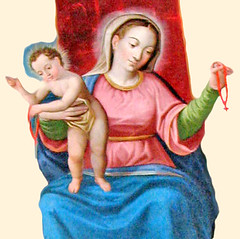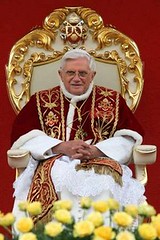Lo! Star-led Sages from the East
 Today the Solemnity of the Epiphany of the Lord principally celebrates the visit of the Magi to the Infant Jesus (Mt 2:1-12) and thus only this account from the Scriptures is read in the course of the Liturgy. However, in the tradition of the Church, this day has been about more than just this one event; it is about instances of the revelation of the glory of the Lord in His incarnate Son. A vestige of this remains in our Liturgy; the Magnificat antiphon at Second Vespers still sings: "The holy day we are keeping is adorned with three mysteries..." and the Office hymn 'Hostis Herodes impie' also sings of these three mysteries. In the time of Jacobus de Voragine, the Dominican writer of the 'Golden Legend', this day celebrated four mysteries. As he explains:
Today the Solemnity of the Epiphany of the Lord principally celebrates the visit of the Magi to the Infant Jesus (Mt 2:1-12) and thus only this account from the Scriptures is read in the course of the Liturgy. However, in the tradition of the Church, this day has been about more than just this one event; it is about instances of the revelation of the glory of the Lord in His incarnate Son. A vestige of this remains in our Liturgy; the Magnificat antiphon at Second Vespers still sings: "The holy day we are keeping is adorned with three mysteries..." and the Office hymn 'Hostis Herodes impie' also sings of these three mysteries. In the time of Jacobus de Voragine, the Dominican writer of the 'Golden Legend', this day celebrated four mysteries. As he explains:"On the feast day of the Lord's epiphany four miracles are commemorated, and therefore the day has four different names. On this day, the Magi adored Christ, John baptized him, he changed water into wine, and he fed five thousand men with five loaves.
When Jesus was thirteen days old, the Magi, led by the star, came to him: therefore the day is called Epiphany, from 'epi', which means above, and 'phanos', meaning an appearing, because then the star appeared from above, or the star, appearing from above, showed the Magi that Christ was the true God. On the same day, twenty-nine years later... then, I say, he was baptized in the Jordan, and therefore the day is called Theophany, from 'theos', meaning God, and 'phanos', apparition. The whole Trinity appeared on that day, the Father by voice, the Son in the flesh, the Spirit as a dove.
On the same day one year later, when he was thirty or thirty-one years plus thirteen days old, he changed water into wine; so the day is called Bethany, from 'beth', house, because by working the miracle in a house he appeared as true God. Still another year thereafter, when he was thirty-one or thirty-two, he fed the five thousand men with five loaves, as Bede says and as we hear in the hymn that is sung in many churches and begins 'Illuminans altissimus'. So the day is called Phagiphany, from 'phagos', which means a mouthful or to eat. There is some doubt, however, whether this fourth miracle appeared on this particular date...
Four appearences, then, happened on this day, the first through the star, in the manger; the second through the Father's voice, ini the Jordan; the third in the changing of water into wine at the wedding feast; the fourth in the multiplication of loaves in the desert. But the first appearence is the principal one celebrated on this date, and so we will go on with that story."
The story of course is about the wise men from the East, astronomers or some say Zoroastrians, kings even, who sighted a cosmological sign, a star of some significance and they followed it to Bethlehem, where they found the Child Jesus and His parents. Seeing the Lord, they bowed and worshipped Him and then avoided Herod in order to save the Child from the king's jealous wrath. As I indicated yesterday, the Magi were led by a star of faith and indeed in them we see the faith of the Gentiles and pagans. As the 'Golden Legend' says:
"The first, the material star, they saw in the East. The spiritual star, which is faith, they saw in their hearts, for if this star of faith had not shone in their hearts, they would never have come to the vision of that first star. They had faith in Christ's humanity... in his royal dignity... and in his divinity."And what might well ask how such faith came to be born in their hearts? Surely it is a wonderful grace of God, the gift of the Holy Spirit which enkindles such faith. Thus, the Office hymn 'Quae stella sole pulchrior' sings that, "While outward signs the star displays, an inward light the Lord conveys and urges them with force benign to seek the Giver of the sign." Or as the 'Golden Legend' speculates:
"Some say it was the Holy Spirit, who appeared to the Magi as a star as he later descended as a dove upon Christ at his baptism. Others including Chrysostom, say that the star was an angel, the same angel who appeared to the shepherds..."
It is widely regarded that there were three visitors from the East since they presented three gifts to the Lord. These gifts have interesting signification, as Jacobus de Voragine goes on to say:

"Why did the Magi offer these three gifts? There are several reasons. The first, it was traditional among the ancients, as Remy says, that no one presented himself empty-handed before a god or a king, and the Persians and Chaldeans were used to offering gifts such as these... Another reason is given by Bernard [of Clairvaux]: they offered gold to the holy Virgin to relieve her poverty, frankincense to dispel the bad odour of the stable, and myrrh to strenghten the child's limbs and drive out harmful worms. A third reason is that gold was offered for tribute, the incense for sacrifice, and the myrrh for burial of the dead. So these three gifts corresponded to Christ's royal power, divine majesty and human mortality. A fourth is that gold symbolizes love, incense prayer, and myrrh the mortification of the flesh; and these three we ought to offer to Christ. Lastly, the gifts signify three attributes of Christ, namely, his most precious divinity, his most devout soul, and his intact and uncorrupted flesh."
Tradition has named these three wise men as Caspar, Balthasar and Melchior. Later Christian art would depict them in the attire of kings of Asia, Arabia and Europe, thus harking to the psalm: "May all kings fall down before him, all nations give him service" (Ps 72:11). As such, fr Geoffrey Preston, OP says:
"The wise men from the East, then, should speak to us of the universality of the Church. They represent, we remember, the wisdom that is outside Israel, outside the religious and cultural tradition which gave birth to Jesus. Yet it is questions stemming from pagan wisdom that bring them to Jesus, the King of the Jews. They come to him with the baggage of various concerns, under the goad of various interests. We may see their gifts as much as indications of those interests as pointers to the role Jesus would play in their view of him. First of all they bring gold. Gold, the sweat of the sun, the metal that indicates politics, and economics, the substance from which royal insignia are fashioned and in which trade is conducted. They bring frankincense, the material of worship, the stuff of the cult of God or the gods; and as wise men they would naturally ask questions of a theological sort, questions about the divine. Lastly, they bring myrrh, the ointment that reeks of death, itself the supreme question mark set against all the activities of man. The gospel of Matthew offers Jesus as an answer to all these questionings, whether political and social, or theological or ethical and philosophical. To the structure of the Gospel belong not only the simple faith of the shepherds that can take an angel's words on trust but also the deepest speculations of the human mind as it strives towards meaning and truth in pagan culture and pagan religion..."
Thus, St Augustine says in his 'Retractions': "The reality itself, which is now called the Christian religion, was also present among the ancients and was not absent from the very beginning in the human race until Christ appeared in the flesh. Then from that point onwards the true religion, which had always existed, began to be called the Christian religion."
So, fr Preston continues:
"The magi set out in their journey as a result of what they learned through their own traditions. They saw a star rising, and their traditional wisdom taught them to interpret the event as a call to love. Through their own cultural media they sought a Messiah, and the seeking moved them in the right direction. But notice that, while their quest is the right quest, in the right direction, it does not come to its goal until the place where their questing can end is pointed out to them by other people. And this is the place of the missionary task..." Therefore, "A church which is not actively missionary is not actively catholic, that is, universal. And a church which is not actively missionary is a monster, because the Church is the embodiment of the mission of the Son and of the Holy Spirit from the Father... The more deeply we enter the mystery of the Church the more missionary our spirit should be"!
As our Liturgy unfolds into the Feast of the Lord's Baptism this Sunday we shall see still more clearly the Trinitarian mission that we share in by baptism and the focus of our lives, that is, to point to Christ, Love incarnate.

The relics of the three kings, now venerated as saints, were taken to the Dominican church in Milan and then transferred to the Cathedral Church of Cologne, where they rest in a splendid shrine (left). These connections explain the importance of the feast in Ambrosian chant, the liturgy of Milan and for the Dominicans. This day is still celebrated with great ceremony in Cologne and I was fortunate to be present at the Cardinal's Mass in that great cathedral on this day, three years ago. This photo was taken on the Solemnity of the Epiphany in 2003, when the shrine was surrounded by candles and flowers. The three large candles in the foreground bear the initials of the three kings and the emblem of a crown.
The images above of the Epiphany of the Lord are taken from a 19th century Roman Missal and an embroidered silk banner in the treasury of Cologne cathedral.







0 Comments:
Post a Comment
<< Home